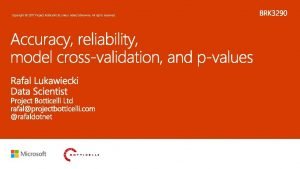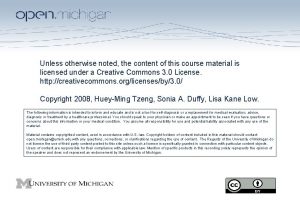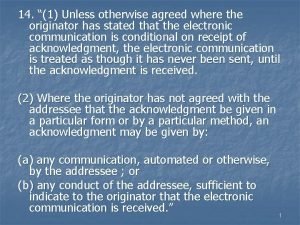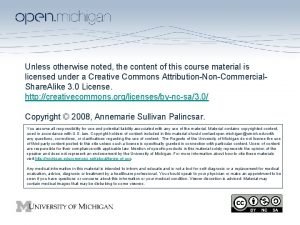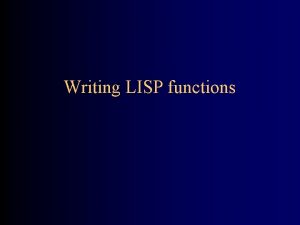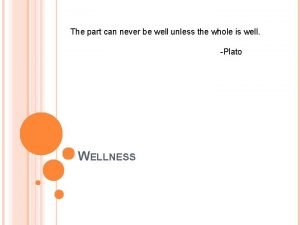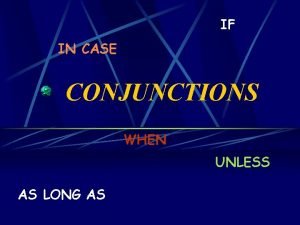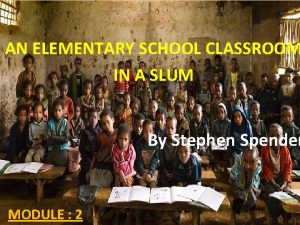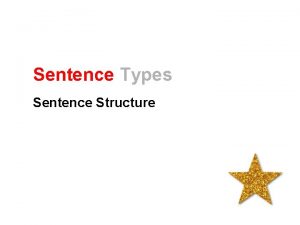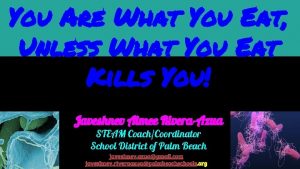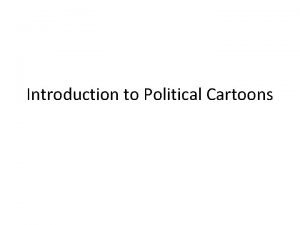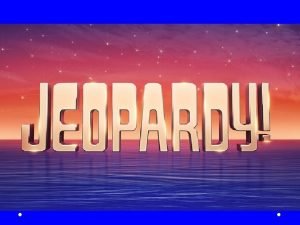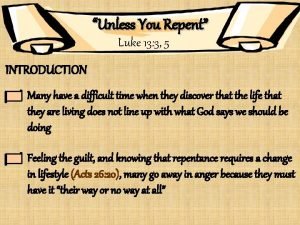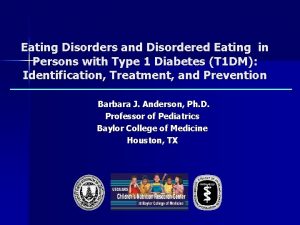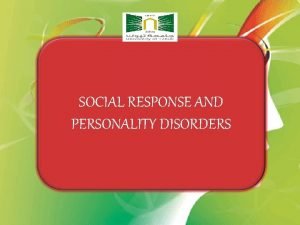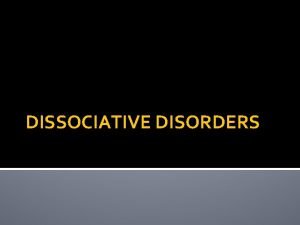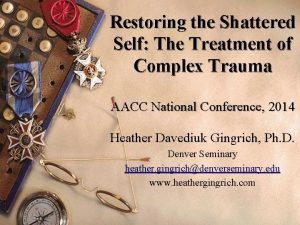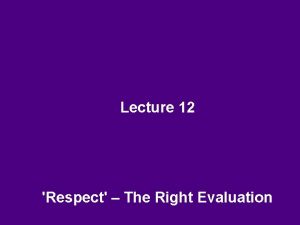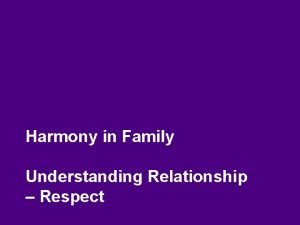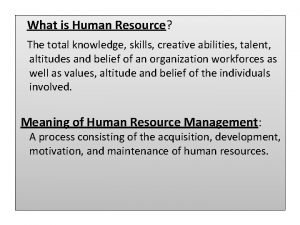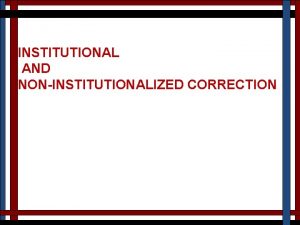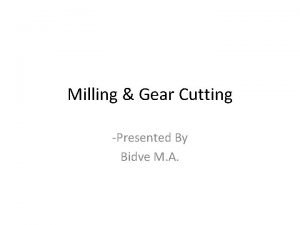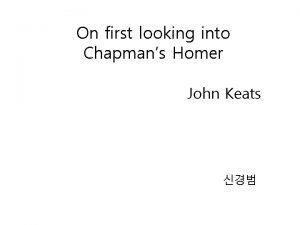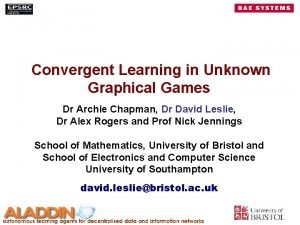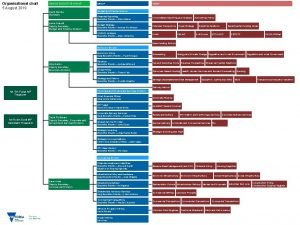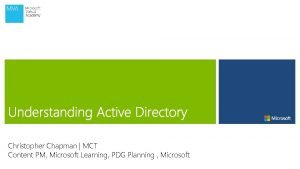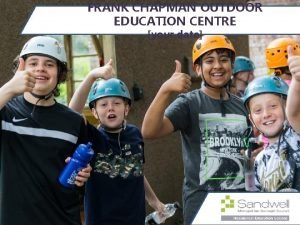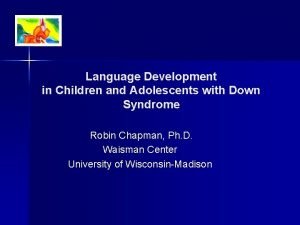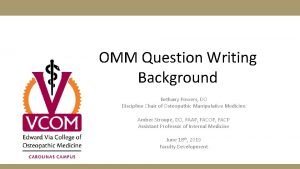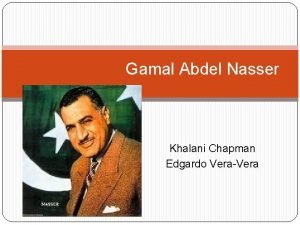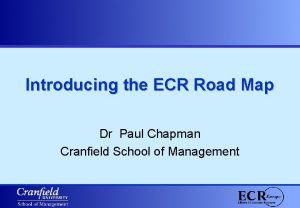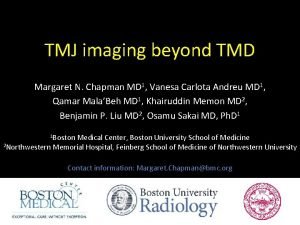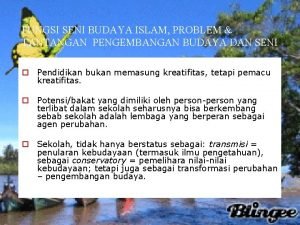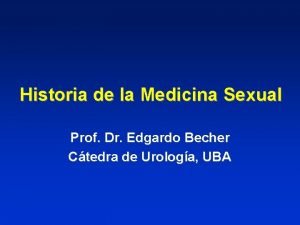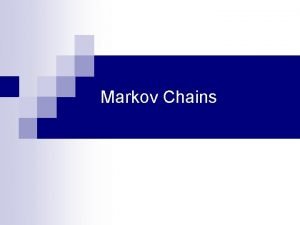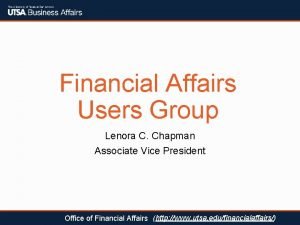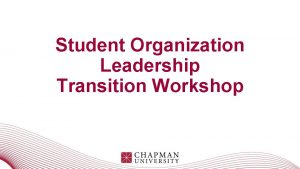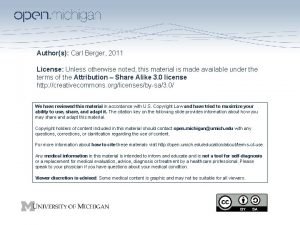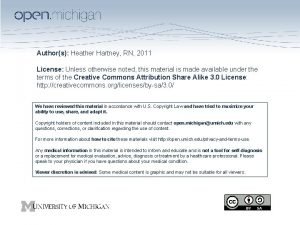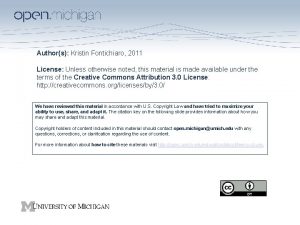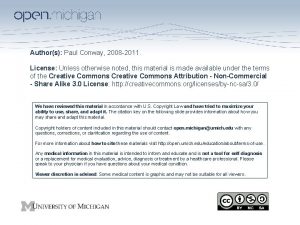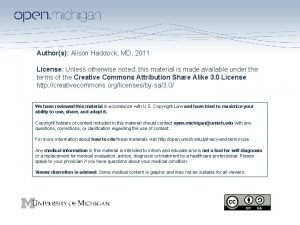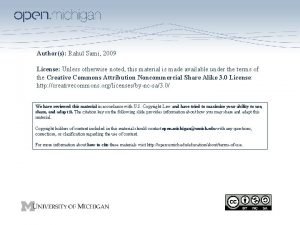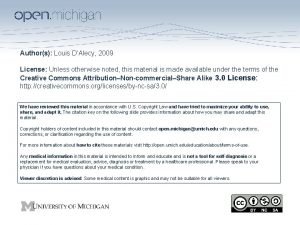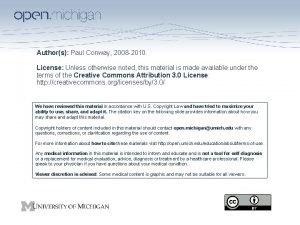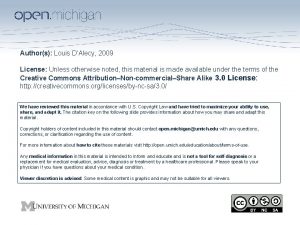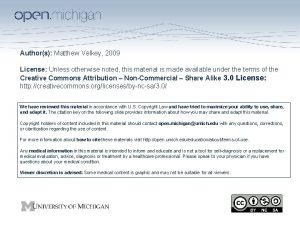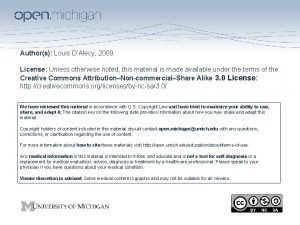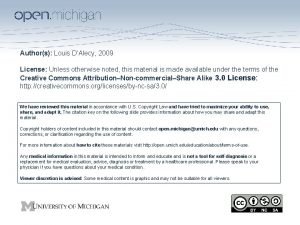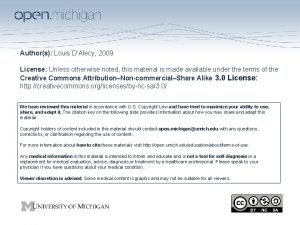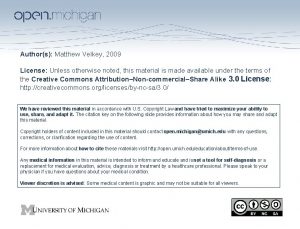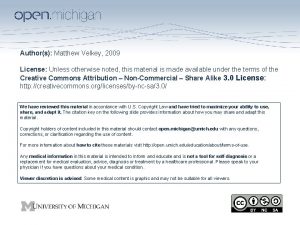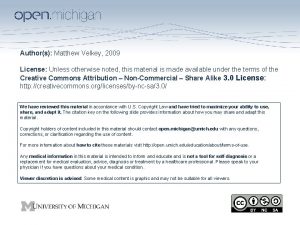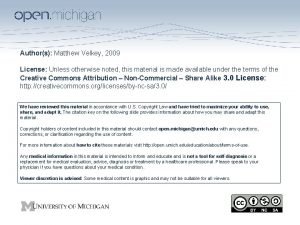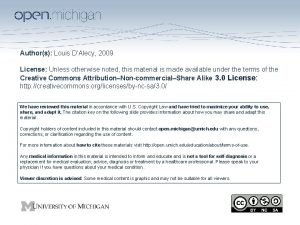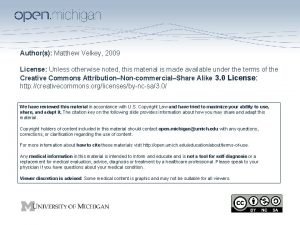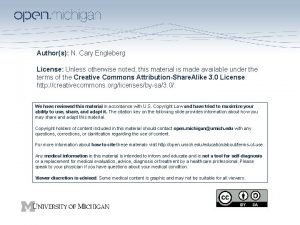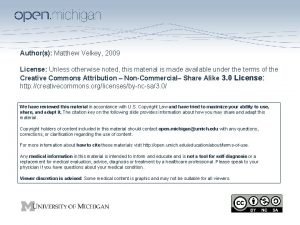Authors Chris Chapman 2011 2012 License Unless otherwise





























































- Slides: 61

Author(s): Chris Chapman, 2011 -2012 License: Unless otherwise noted, this material is made available under the terms of the Creative Commons Attribution 3. 0 License: http: //creativecommons. org/licenses/by/3. 0/ We have reviewed this material in accordance with U. S. Copyright Law and have tried to maximize your ability to use, share, and adapt it. The citation key on the following slide provides information about how you may share and adapt this material. Copyright holders of content included in this material should contact open. michigan@umich. edu with any questions, corrections, or clarification regarding the use of content. For more information about how to cite these materials visit http: //open. umich. edu/privacy-and-terms-use. Any medical information in this material is intended to inform and educate and is not a tool for self-diagnosis or a replacement for medical evaluation, advice, diagnosis or treatment by a healthcare professional. Please speak to your physician if you have questions about your medical condition. Viewer discretion is advised: Some medical content is graphic and may not be suitable for all viewers. 1

Citation Key for more information see: http: //open. umich. edu/wiki/Citation. Policy Use + Share + Adapt { Content the copyright holder, author, or law permits you to use, share and adapt. } Public Domain – Government: Works that are produced by the U. S. Government. (17 USC § 105) Public Domain – Expired: Works that are no longer protected due to an expired copyright term. Public Domain – Self Dedicated: Works that a copyright holder has dedicated to the public domain. Creative Commons – Zero Waiver Creative Commons – Attribution License Creative Commons – Attribution Share Alike License Creative Commons – Attribution Noncommercial Share Alike License GNU – Free Documentation License Make Your Own Assessment { Content Open. Michigan believes can be used, shared, and adapted because it is ineligible for copyright. } Public Domain – Ineligible: Works that are ineligible for copyright protection in the U. S. (17 USC § 102(b)) *laws in your jurisdiction may differ { Content Open. Michigan has used under a Fair Use determination. } Fair Use: Use of works that is determined to be Fair consistent with the U. S. Copyright Act. (17 USC § 107) *laws in your jurisdiction may differ Our determination DOES NOT mean that all uses of this 3 rd-party content are Fair Uses and we DO NOT guarantee that your use of the content is Fair. 2 To use this content you should do your own independent analysis to determine whether or not your use will be Fair.

Empowering the Medical School Educator to Teach More Effectively By: Chris Chapman, Media Services Manager, Multi. Media Development, University of Michigan Medical School Assignment for: Principles of Classroom Learning - Eastern Michigan University - 2011 You Will Learn to… • • • Teach learners to remember & use what they learn Design your instruction around important concepts Think creatively Make your small groups more collaborative Use motivation in learning & professional practice Build review & reinforcement into your instruction Mercy Health, flickr Alternate images available from http: //www. med. umich. edu/lrc/medcurriculum/ Sousa (2009) 3

Table of Contents Section Topic 1 Learning Objectives 2 What is Learning? 3 Small Group Discussion: Can Your Students “Meaningfully Learn” from Lectures? 4 Making the Case: Why We Need to Teach Creative Thinking in a Scientific Curriculum 5 All Class Discussion: Is there a Place for Creative Thinking in Clinical Practice? 6 Meaning Making for the Medical Student 7 Small Group Discussion: How Much Gross Anatomy is Necessary for the Undergraduate Medical Student? 8 Break (with snack) 9 Improving Your Lectures, Part 1 4

Table of Contents (cont. ) Section Topic 10 Break (with Yoga) 11 Motivation and Learning 12 Paired Discussion: What Motivates You? 13 Lunch (with video) 14 Improving Your Lectures, Part 2 15 Integrating Your Course 16 Small Group Discussion: What Opportunities do You have for Implementing Reinforcement? 17 Small Group Success 18 Break (with Yoga) 19 Moving Forward (Closure with All Class Discussion) 20 References 5

Table of Contents (cont. ) Appendix Topic A Handout 1: A Closer Look at Active Teaching and Learning B Handout 2: Effects of Spacing and Embellishment on Memory for the Main Points of a Text C Workshop Outline D Workshop Chart 6

1) Learning Objectives You Will Learn to… • • • Teach learners to remember & use what they learn Design your instruction around important concepts Think creatively Make your small groups more collaborative Use motivation in learning & professional practice Build review & reinforcement into your instruction Mercy Health, flickr 7

2) What is Learning & Instruction? “Learning • • • Is a change In what the learner knows Caused by a learning experience” “Instruction is • Manipulating what the learner experiences • With the intention to cause a change in the learner’s knowledge” (Mayer, 2011, p. 14). (Mayer, 2011, p. 52). Are you intentional in your instructional practices? 8

Learning and Instruction (Mayer, 2011, p. 52) 9

Aim for “Deep Learning” • Characteristics of Deep Learning – – – Significant cognitive processing Learner makes an effort to make sense of the material The learning is remembered The learning can be used in future situations Deep learning is meaningful to the learner (Mayer, 2011) 10

A Closer Look at Active Teaching and Learning • Please read the HANDOUT 1 entitled, “A Closer Look at Active Teaching and Learning” (Mayer, 2011, pp. 86 -87). 11

3) Small Group Discussion (15 min) • Can your students “meaningfully learn” from lectures? • If so, how? • If not, why? 12

4) Making the Case: Why We Need to Teach Creative Thinking in a Scientific Curriculum Chris Chapman - Principles of Classroom Learning - Eastern Michigan University - 2011 What You Will Learn • • Why scientists (and your students) need to be able to think creatively The differences between creative and critical thinking How Bloom’s Revised Taxonomy can help you understand the relationship between creative and critical thinking Ways to develop creative thinking in your students Jorge. Miente. es, flickr Sousa (2009) 13

Why We Need Creativity in Science How to Succeed in Science “There are four requirements for a successful career in science: knowledge, technical skill, communication, and originality or creativity. Many succeed with largely the first three. Those who are meticulous and skilled can make a considerable name by doing the critical experiments that test someone else’s ideas or by measuring something more accurately than anyone else. But in such areas of science as biology, anthropology, medicine, and theoretical physics, more creativity is needed because phenomena are complex and multivariate” (Loehle, 1990). Please see original image of the “Ph. D Research Process” guide from the Mechanosynthesis Group at the University of Michigan ( http: //www. mechanosynthesis. com/). 14

Defining Critical and Creative Thinking Before I convince you that developing the creative thinking skills in your students is essential, I must first describe two main terms used in this presentation: • Critical thinking • Creative thinking Sousa (2009) wenedeux, flickr bourgeoisbee, flickr 15

What is Critical Thinking? bourgeoisbee, flickr “Critical thinking is a complex process that is based on objective standards and consistency. It includes making judgments using objective criteria and offering opinions with reasons” (Sousa, 2006, p. 246). Being able to think critically is an essential skill for all scientists. Some might argue that critical thinking is the foundation of the scientific method. Schools often emphasize the development of critical thinking skills in their curricula (e. g. , remembering facts, understanding and applying theories, etc. ). However, schools also need to help students develop their creative thinking skills. Lab Science Career, flickr 16

What is Creative Thinking? Steve Jobs on Creative Thinking “Creativity is just connecting things. When you ask creative people how they did something, they feel a little guilty because they didn’t really do it, they just saw something. It seemed obvious to them after a while. That’s because they were able to connect experiences they’ve had and synthesize new things. And the reason they were able to do that was that they’ve had more experiences or they have thought more about their experiences than other people” (Wolf, 1996). Figure 1. Steve Jobs with the i. Phone 4 in 2010 (Yobe, 2010). Matt Yohe, Wikimedia Commons Make sure you understand that although creativity is often associated with the arts, music, theatre, etc. In this context, creativity is a cognitive process that can include, but ultimately goes beyond “the arts. ” 17

Comparison: Critical Thinking vs. Creative Thinking Critical thinking tends Creative thinking to be more. . . tends to be more… Linear Non-linear, iterative Rational/Reasoned Intuitive Quantitative Qualitative Objective Subjective Convergent Divergent 18

Use Bloom’s Revised Taxonomy to Understand Critical and Creative Thinking Bloom’s Revised Taxonomy (Figure 2) is a model that represents six level of human cognition. The categories are on a continuum moving from least complex (remember) to most complex (create). Creative thinking is not simply found in the “create” category, but in lower levels as well. There is no sharp divide between creative thinking and critical thinking, as people move fluidly between the levels (Sousa, 2006). Use the notation of the sides of the picture further differentiate and discern your understanding of creative and critical thinking. Figure 2. Bloom’s Revised Taxonomy as adapted from Sousa (2009). Make sure you understand that “complexity” refers to the level of cognitive processing one has to use to work with information. “Remember” is a simple form of cognitive processing, while, at the top of the taxonomy, “Evaluating” and “Creating” are more sophisticated and “complex” forms of cognitive processing (Sousa, 2006). 19

Teach Your Students to Think Creatively Jorge. Miente. es, flickr Creative thinking is a process that can be taught and learned. It is a process that is concerned with generating new ideas, breaking out of old patterns, and looking at things differently (de Bono, 2010). One method for developing the creative process of the individual or the group is to use the Six Thinking Hats method (de Bono, 1999). In this method, students are asked to think in various ways. For your class, an activity is to simply ask students to “wear one of the hats” while describing their response to an idea or situation, or coming up with a new idea. Six Thinking Hats (de Bono, 1999) • Red hat (emotion): simply ask students to describe how they feel about the topic, idea, etc. without justification. • Black hat (what’s wrong with the idea): ask students to provide reasons why an idea will not work. • Yellow hat (what’s good about the idea): ask students to state positive possibilities or outcomes about an idea. • White hat (the facts): ask students to list the facts and only the facts about the idea or topic. • Green hat (out of the box): ask students to generate new ways of thinking about the idea without worrying about “practicalities. ” • Blue hat (decision time): ask students to make a decision or create a plan based on the ideas, thoughts, and feelings from the other hats. 20

Borrow this Scientist’s Approach to Teach Your Students the “How” of Creative Thinking In his “Ph. D Research Guide, ” John Hart (2011) offers his Mechanical Engineering doctoral students the following advice or principles to follow to develop and expand their creative thinking skills: The Process of Being Creative (How) • Always ask questions • What, why, where, how • Explain your ideas to others, talk with experts • What do they ask about? • Systematic variation • Consider all permutations • Reversal and reciprocity • Start with the end goal and work backwards • Take your current idea and do the opposite 21

5) All Class Discussion (15 min) • Is there a place for creative thinking in clinical practice? – – – Yes? No? Obstacles? Opportunities? Elaborate Sousa (2009) 22

6) Meaning Making for the Medical Student • Organize information around clinical problems • Focus on the key concepts • Avoid redundant information • Avoid unnecessary details • Reinforce the key concepts throughout – Each learning activity (lecture, group, etc. ) – The entire course Mercy Health, flickr 23

Organize Information Around Clinical Problems • Learning can be facilitated when the learning is related to a future situation (similarity, hugging) (Sousa, 2006) • For medical students, this means relating information to clinical situations and problems Mercy Health, flickr 24

Use “Similarity” and “Hugging” in Medical Education Discipline Clinical Application Anatomy Surgery Physiology Disease presentation Communication skills Patient interviewing Pharmacology Pharmaceutical treatment Key Point: Connect a clinical application to the discipline being taught. 25

Use Case-based Teaching Methods to Link Learning to Clinical Practice Downloaded from the University of Michigan Medical School 26

Teach the Key Concepts • Numerous studies suggest learning increases when: – Key concepts are emphasized • Summarized information is superior for learning – Redundant information is reduced • Don’t provide multiple references, sources, descriptions – Embellishments are reduced • Embellishments and extra details overload the learner (Jensen, 2008; Mayer, 2011; Reder & Anderson, 1982) 27

Reinforce the Key Concepts • Studies report learning increases when: – Key concepts are reinforced throughout: • Each learning experience (e. g. , lecture, lab, etc. ) • Longitudinally throughout a sequence of learning experiences (e. g. , a course or curriculum) (Jensen, 2008; Mayer, 2011; Reder & Anderson, 1982) 28

Time Out: A Thoughtful Review of the Literature • Please read HANDOUT 2 entitled, “Effects of spacing and embellishment on memory for the main points of a text” (Reder & Anderson, 1982). 29

Summary: Deepening Your Students’ Learning How to deepen learning: • Focus on the essential information • Don’t overload the student with too much information • Promote practice and review in the learning environment • Students are more likely to retain learning when they have to reprocess the information 30

7) Small Group Discussion (15 min) • How much gross anatomy is necessary for the under graduate medical student? • What are the core concepts that all first-year medical students need to know? Please access the University of Michigan Gross Anatomy website to use as a reference for your discussion: http: //www. med. umich. edu/lrc/coursepages/m 1/anatomy 2010/html/courseinfo /labs_systemic. html http: //www. med. umich. edu/lrc/coursepages /m 1/anatomy 2010/html/courseinfo/labs_sys temic. html 31

8) Break (15 min) • Bio-break (5 min) • Light stretching and breathing (10 min) – Exercise improves mood and enhances cognitive abilities (Sousa, 2006) – Use the Russa Yog video to guide the activity – http: //russayog. com/me dia/videos/ Please see original image of russa yoga screen shot at http: //russayog. com/media/videos/ Russa Yoga video available at http: //russayog. com/media/videos/ 32

9) Improving Your Lectures, Pt. 1 • Move towards meaning making: – Organize information around clinical schema – Focus on key concepts (Reder & Anderson, 1982) – Remove embellishments (Reder & Anderson, 1982) – Use relevant pictures (Mayer, 2011) Cristiana Care, flickr 33

Cristiana Care, flickr Improving Your Lectures, Pt. 1 (cont. ) • Use polling and discussion to promote deep learning (more cognitive processing) in the learners • Techniques: – Audience Response Systems – Hand raising – Paired or small group discussions 34

Cristiana Care, flickr Improving Your Lectures, Pt. 1 (cont. ) • Revisit and review information – In each lecture – Across lecture sequences (Jensen, 2008; Mayer, 2011; Reder & Anderson, 1982) 35

Reduce & Review Example Cristiana Care, flickr An example from a lecture series From the Research: a cohort of students was divided into three groups. High received three lectures with 90% new material, medium with 70%, and low with 50%. Each group had the same amount of lecture time (low density lectures had more reinforcement time). Low density learners performed better on the Posttest 1 and Posttest 2 (15 days after the class) (Jensen, 2008). Source Undetermined 36

10) Short Break (10 min) • Break • Modest amounts of fruit (because of the glucose) can improve attention and brain function (Sousa, 2006). • Try fruit instead of coffee at the break and suggest it to your students and patients. msr, flickr Fernando Stankuns, flickr 37

11) Motivation and Learning • There are two basic forms of motivation – Intrinsic (motivation that comes from within, does not depend on outside factors, is personal) – Extrinsic (motivation that comes from without, the desire to obtain something based on external factors) • Motivational factors exist on a continuum, ranging from pure extrinsic to pure intrinsic, and in between (Pokay, 2011) 38

Motivation and Learning (cont. ) Another way to think of motivation is this differentiated motivational model (Mayer, 2011). Source Undetermined 39

Motivation and Learning (cont. ) • It is assumed that Medical Students are highly motivated (otherwise they would not of been able to make it to medical school) • However, as a teacher, you will come across students with different backgrounds and different motivations for studying medicine • Understanding your own motivations and those of others may help you to empathize and guide your students 40

12: Paired Discussion: What Motivates You? Use this differentiated motivational model by Mayer (2011) to work with your partner to explore the various facets of the motivational characteristics of your own professional life. Source Undetermined 41

13) Lunch (45 min) spcbrass, "Peanut Butter • Enjoy lunch • We will watch this video by Daniel Pink entitled “The Surprising truth about what motivates us” (10: 48) • An informal discussion will follow Please see original image of video screenshot at http: //www. youtube. com/watch? v=u 6 XAPnu. Fj. Jc “The Surprising truth about what motivates us” is available at http: //www. youtube. com/watch? v=u 6 XAPnu. Fj. Jc 42

14) Improving Your Lectures, Pt. 2 Cristiana Care, flickr • To help your learners retain what they are taught in a lecture: – Start and finish with the most important content • Prime-time-1 & Prime-time -2 – Put the least important content in the middle • Down-time (Sousa, 2006) 43

Cristiana Care, flickr Improving Your Lectures, Pt. 2 (cont. ) • Present new information at the beginning (Prime-time 1) • Allow students to mentally reprocess (closure) the material at the end (Prime-time-2) • Allow for practice, review, business, etc. in the middle (Down-time) (Sousa, 2006) 44

Cristiana Care, flickr Improving Your Lectures, Pt. 2 (cont. ) Consider segmenting your 50 minute lectures into two 20 -25 minute lectures. Use the time between segments for business, humor, stretching, etc. This will result in more net-learning time (see table below). (Sousa, 2006) 45

15) Integrating Your Course • Design your course so your students can master the key concepts – Identify the key concepts (Reder & Anderson, 1982) – Teach the key concepts • Resist the temptation to add unnecessary details (Reder & Anderson, 1982) – Tie the information to a clinical schema and the course themes – Actively revisit core concepts throughout each – lecture, small group, lab, etc. (Reder & Anderson, 1982) 46

Integrating Your Course (Mayer, 2011, p. 52) As the course director, you can design the course experiences to focus on core concepts and intentionally revisit and review the core concepts. 47

16) Small Group Discussion (15 min) • Does your course intentionally incorporate experiences to revisit core concepts? • If so, how well? • If not, how would you? 48

17) Small Group Success • In some ways, small groups are like professional meetings • Break into small groups and discuss the following question (15 min): – What are some of the frustrations that you have with your professional meetings (e. g. , not always comfortable sharing, they are not productive, etc. )? 49

Small Group Success (cont. ) • Conditions for success in small group learning: – The structure should support cooperation AND collaboration – The meeting structure should easily encourage and solicit multiple perspectives – Decision making should be transparent – If part of a course, use the small group to revisit and reinforce key concepts taught in other parts of the course 50

Small Group Success (cont. ) Small group learning should support BOTH cooperation AND collaboration. Note: cooperation & collaboration are often used synonymously BUT they actually two very different forms of interaction. See table below for a comparison. Cooperation Collaboration Task based work Roles change Separate roles Undefined goals Structured tasks Solutions negotiated by participants through communication Specific end or goal Open-ended questions/problems Close-ended questions/problems Can involve arguing, tension, etc. in the process (Egbert, 2009) 51

Small Group Success (cont. ) Small group learning should encourage multiple perspectives. There are many methods that can be used to support multiple perspectives in small groups. Examples or process that support group creativity include: • Brainstorming • Group mind mapping • Parallel thinking (Six Thinking Hats) (de Bono, 1999) The goal of these processes is to allow multiple points of view and perspective to be shared in the group process with minimal restriction or censoring. This allows everyone to participate in the conversation and direction of the solution. An especially powerful technique to promote group creativity is the Six Thinking Hats method. See the next slide for more information. 52

Small Group Success (cont. ) One method for developing the creative process of the individual or the group is to use the Six Thinking Hats method (de Bono, 1999). In this method, students are asked to think in various ways. For your class, an activity is to simply ask students to “wear one of the hats” while describing their response to an idea or situation, or coming up with a new idea. Six Thinking Hats (de Bono, 1999) • Red hat (emotion): simply ask students to describe how they feel about the topic, idea, etc. without justification. • Black hat (what’s wrong with the idea): ask students to provide reasons why an idea will not work. • Yellow hat (what’s good about the idea): ask students to state positive possibilities or outcomes about an idea. • White hat (the facts): ask students to list the facts and only the facts about the idea or topic. Using this method as part of group process is way to get many different points of view “on the table. ” • Green hat (out of the box): ask students to generate new ways of thinking about the idea without worrying about “practicalities. ” If a decision is to be made, the “Blue Hat” is worn. See the next slide for more about decision making. • Blue hat (decision time): ask students to make a decision or create a plan based on the ideas, thoughts, and feelings from the other hats. 53

Small Group Success (cont. ) When the group process must go beyond talking and a decision needs to be made, an explicit decision-making process should be enacted. See below for decision-making models. Type Description Command Group leader or other trusted individual makes final decision. Consult An external authority or expert in the field of interest evaluates the information generated by the group and makes the decision. Vote Use when there are several good options to choose from. Do not use if some group members will not support the final vote. Consensus Use with high stakes/complex issues or when everyone must support the final decision. (Patterson, Grenny, Mc. Millian, & Switzler, 2002) 54

Small Group Success (cont. ) If the small group is part of a course, use the small group to review and revisit key component of the overall course. You can use synergy (people working and interacting together) to: • Model behaviors • Check for understanding • Clarify misunderstanding • Reinforce and build on key concepts (Sousa, 2006) 55

Small Group Success (cont. ) • Small group discussion: – Think back to the “Six Hats” method. Which is your favorite hat to wear when participating in a discussion? – Is cooperation really different than collaboration? Elaborate. – What are the pros and cons of using a vote to make a group decision? 56

18) Break (15 min) • Bio-break (5 min) • Light stretching and breathing (10 min) – Exercise improves mood and enhances cognitive abilities (Sousa, 2006) – Use the Russa Yog video to guide the activity – http: //russayog. com/me dia/videos/ Please see original image of russa yoga screen shot at http: //russayog. com/media/videos/ Russa Yoga video available at http: //russayog. com/media/videos/ 57

19) Moving Forward - Closure Class Discussion – Let’s Remember the Key Points with Reflection & Discussion Part One • Each person is to take five minutes, reflect upon what they learned today, and write down the one or two concepts you would like to apply to your teaching. Part Two • Each person shares with the group their key points. 58

20) References • • • de Bono, E. (2010). Lateral thinking: Creativity step by step (EPub Edition). New York, NY: Haper. Collins Publishers Inc. de Bono, E. (1999). Six thinking hats. Boston, MA: Little, Brown and Company Egbert, J. (2009). Supporting learning with technology: Essentials of classroom practice. Upper Saddle River, New Jersey: Pearson Education, Inc. Hart, A. J. (2011). Creativity; the scientific mind. Document posted at the University of Michigan Mechanosynthesis Group website. Retrieved from http: //www. mechanosynthesis. com/wp-content/uploads/resprocslides/ajohnh-RPW 11 -L 03 creativityandmethod. pdf Jensen, E. (2008). Brain-based learning (2 nd Edition). Thousand Oaks, CA: Corwin Press. Loehle, C. (1990). A Guide to increased creativity in research – inspiration or perspiration? Bioscience, 40(2), 123 -129. Mayer, R. E. (2011). Applying the science of learning. Boston, MA: Allyn & Bacon. Patterson, K. , Grenny, R. , Mc. Millan, R. , & Switzler, A. (2002). Crucial conversations: Tools for talking when stakes are high. New York, NY: Mc. Graw-Hill Pokay, P. (2011). Motivation. Posted at the Eastern Michigan University Educational Psychology 603 course website (secure). Reder, L. M. & Anderson, J. R. (1982). Effects of spacing and embellishment on memory for the main points of a text. Memory & Cognition, 10(2), 97 -102. Sousa, D. A. (2006). How the brain learns (3 rd Edition). Thousand Oaks, Ca: Corwin Press. Wolf, G. (1996). Steve Jobs: The Next insanely great thing. Wired, 4(2). Retrieved from http: //www. wired. com/wired/archive/4. 02/jobs. html Licensing/Image Credits • • Yohe, M. (Photographer). (2010). Steve Jobs Headshot. [Digital image]. Retrieved from http: //en. wikipedia. org/wiki/File: Steve_Jobs_Headshot_2010 -CROP. jpg. This file is licensed under the Creative Commons Attribution-Share Alike 3. 0 Unported license. Slides 7 & 14 (Butterfly Dreamer); Slide 9 & 10 (Chalkboard); Slides 9 & 16 (Puzzle Dreamer); Slide 10 (Scientist): Royalty free licensing from http: //www. dreamstime. com/ 59

Appendix A • Handout 1: A Closer Look at Active Teaching and Learning (Mayer, 2011) 60

Appendix B • Handout 2: Effects of Spacing and Embellishment on Memory for the Main Points of a Text (Reder & Anderson, 1982) 61
 Unless noted otherwise
Unless noted otherwise Huey-ming tzeng
Huey-ming tzeng Unless otherwise agreed
Unless otherwise agreed Unless otherwise noted meaning
Unless otherwise noted meaning Unless lisp
Unless lisp The part can never be well unless the whole is well
The part can never be well unless the whole is well Oraciones unimembres
Oraciones unimembres A unless b
A unless b Lisp unless
Lisp unless In case unless
In case unless Unless you repent you will all likewise perish
Unless you repent you will all likewise perish Elementary classroom in a slum poetic devices
Elementary classroom in a slum poetic devices The weather has been nice but it may snow again any day
The weather has been nice but it may snow again any day Sandy feels dirty unless she bathes and changes
Sandy feels dirty unless she bathes and changes Unless
Unless Unless what
Unless what The trust giant's point of view
The trust giant's point of view Romeo and juliet act 1 jeopardy
Romeo and juliet act 1 jeopardy I my sister with her homework last night
I my sister with her homework last night Unless you repent
Unless you repent Dissociative disorder not otherwise specified
Dissociative disorder not otherwise specified Dissociative disorder not otherwise specified
Dissociative disorder not otherwise specified Dissociative amnesia
Dissociative amnesia The limited access zone of a masonry wall must be
The limited access zone of a masonry wall must be Bask model of dissociation
Bask model of dissociation Right evaluation examples
Right evaluation examples Over/under/otherwise evaluation is
Over/under/otherwise evaluation is Objectives of hra
Objectives of hra R.a. 9344
R.a. 9344 Bill 393
Bill 393 In compound indexing index crank movement 40/n
In compound indexing index crank movement 40/n What is republic act no. 10912 all about
What is republic act no. 10912 all about Then felt i like some watcher of the skies
Then felt i like some watcher of the skies Dr archie chapman
Dr archie chapman Marian chapman dtf
Marian chapman dtf Lisa chapman ubs
Lisa chapman ubs Pdg microsoft
Pdg microsoft Patricia nemeth united nations
Patricia nemeth united nations Frank chapman centre
Frank chapman centre Terreno di chapman
Terreno di chapman Robbin chapman
Robbin chapman Mark david chapman catcher in the rye
Mark david chapman catcher in the rye Electrostatic spraying jupiter
Electrostatic spraying jupiter Chapman
Chapman Cayuse irb
Cayuse irb Viscerosomatic reflex
Viscerosomatic reflex Edgardo chapman
Edgardo chapman Dr paul chapman
Dr paul chapman Chapman mechanism
Chapman mechanism Margaret chapman md
Margaret chapman md Pdg microsoft
Pdg microsoft Simone aria
Simone aria Fungsi individual seni
Fungsi individual seni Edgardo chapman
Edgardo chapman Gary chapman test
Gary chapman test Chapman flask moisture chart
Chapman flask moisture chart Homogeneous markov chain
Homogeneous markov chain Chapman university
Chapman university Relação de transformação
Relação de transformação Lenora chapman
Lenora chapman 25live chapman
25live chapman Chapman microsoft office
Chapman microsoft office
